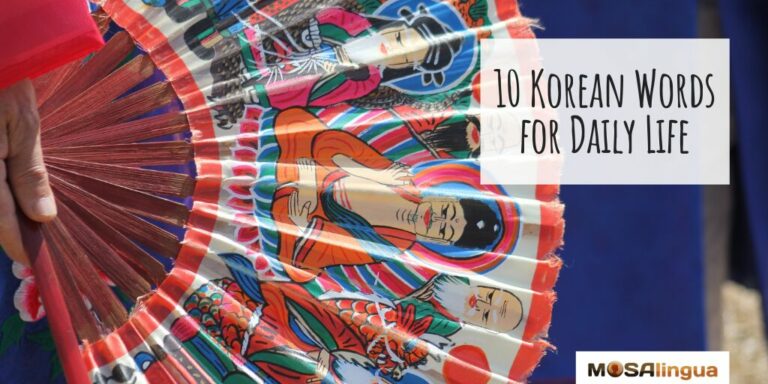If you want to learn Korean, an important first step is building a foundation in Korean vocabulary. Even if you’re only interested in the basics for a short trip, this article will be very useful for you! Our Korean instructor Dawn shares 10 important phrases for growing your everyday Korean vocabulary. If you’d like some pronunciation tips, you can also head down to the end of the article to watch Dawn’s video.

Everyday Korean Vocabulary
안녕하세요 / 안녕 – Hello
The words 안녕하세요 (annyeonghaseyo) and 안녕 (annyeong) are two different ways to greet a person in Korean.
It’s important to note that there are two ways to speak this language: there’s the formal form, called “honorific” and the informal form.
The first version of “hello” – 안녕하세요 – is honorific, while the second – 안녕 – is a more casual “hello” or “hi.”
You can see that these two words are written and pronounced very similarly. Here, the particle 요 (yo) at the end of the word makes it honorific/formal. In general, the honorific version is used for situations where you’re speaking with a stranger. So always use 안녕하세요 (annyeonghaseyo) with people you don’t know well.
감사합니다 / 고마워 – Thank you
Next, we have 감사합니다 (kamsahabnida) and 고마워 (komawo). These mean “thank you” in Korean.
감사합니다 (kamsahabnida) is the honorific form.
And 고마워 (komawo) is the casual form.
It is important to be respectful when you’re traveling. Local people will be more open with you and will be happier to help you if you need it. In this case, you’ll use 감사합니다 (kamsahabnida) a lot!
잠시만요 – Excuse me (= let me pass)
잠시만요 (jamsimanyo) translates literally as “one second” or “wait a minute.” But Koreans use this expression to say “excuse me.”
So, for instance, when you’re on a busy sidewalk or if someone is blocking your way, you can always say 잠시만요 (jamsimanyo) to get past.
저기요 – Excuse me (to get someone’s attention)
저기요 (jeogiyo) is also a way to say “excuse me” in Korean. But in this case, it’s used to grab someone’s attention or to call someone.
For example, if you’re trying to call the server in a restaurant, you could do so by saying 저기요 (jeogiyo).
괜찮아요 / 괜찮아 – I’m good / No, thank you
괜찮아요 (gwaenchanayo) and 괜찮아 (gwaenchana) have two meanings: “I’m good”/”It’s ok” and “No, thank you.
If someone asks “How are you?” or “Are you ok?” You can always respond with 괜찮아 (gwaenchana) or 괜찮아요 (gwaenchanayo).
괜찮아요 (gwaenchanayo) is also used to say “No, thank you.” So, if you want to turn something down politely, you can just add: 괜찮아요.
For example: 아니요, 괜찮아요 (aniyo, gwenchanayo) = “No, thank you.”/”No, I’m ok.”
죄송합니다 / 미안해 – I’m sorry
The words 죄송합니다 (joesonghabnida) and 미안해 (mianhae) are also very important to know. Though these expressions are quite different from one another in terms of spelling, they both mean “I’m sorry” in honorific and casual forms, respectively.
If you bump into someone on the street, you can say: 죄송합니다 (joesonghabnida).
Or if they are your friend, you can say 미안해 (mianhae) or simply 미안 (mian).
네 / 응 – Yes
This one is easy! The words 네 (ne) and 응 (eung) mean “yes.”
If someone asks 괜찮아 (gwaenchana) (“Are you alright?”), you can reply with:
- 응 (eung) = “Yes.” Or, you could also say: 응 괜찮아 (eung gwaenchanh-a) = “Yes, I’m good.”
- or 네, 괜찮아요 (ne, gwenchanayo) = “Yes, I am good.” [formal]
아니요 / 아니 – No
Next, of course, there is 아니 (ani) or 아니요 (aniyo), which menas “no.”
Anytime you want to say no but don’t want to come off as impolite, you can add 괜찮아요 (gwaenchanayo). All together, it would be: 아니요, 괜찮아요 (aniyo, gwaenchanayo) = “No, that’s alright” [formal] / 어디에요 (ani, gwaenchana) = “No, that’s alright” [informal].
어디에요 – Where is…?
Next, there is 어디에요 (eodieyo). 어디에요 means “Where is…?”
Here are a few examples:
- 지하철역이 어디에요? (Jihacheolyeogi eodieyo?) = Where is the subway station?
- 화장실이 어디에요? (Hwajangsili eodieyo?) = Where are the toilets?
- You can also just say “… 어디에요?” (… eodieyo?) = Where is…? and point to the location on a map.
주세요 – Give me (something), please
Finally, the last phrase on our list is 주세요 (juseyo). It’s kind of like the equivalent of “please,” but it’s not exactly the same. In fact, there is no word for “please” in Korean, because it’s already implied. So, when you say 주세요 (juseyo), you’re saying something like “Give me (x), please” / “Could you give me (x), please?”
For example, when you’re ordering food in a restaurant, you can say:
- 아이스크림 주세요 (ice cream, juseyo) = (Can you give me) an ice cream, please?
- Or 비빔밥 주세요 (bibimbap, juseyo) = (Can you give me) some bibimbap, please?
Everyday Korean Vocabulary – Summary Table
These 10 everyday Korean vocabulary words are a crucial foundation. They will make it so you can start conversations with native speakers, and you’re sure to have an even better time while traveling if you know some basics.
| 안녕하세요 | annyeonghaseyo | Hello (formal) |
| 안녕 | annyeong | Hi (informal |
| 감사합니다 | kamsahabnida | Thank you (formal) |
| 고마워 | komawo | Thank you (informal) |
| 잠시만요 | jamsimanyo | Excuse me = let me pass |
| 저기요 | jeogiyo | Excuse me = Could I have your attention? |
| 괜찮아요 | gwaenchanayo | I am good (formal) No, thank you |
| 괜찮아 | gwaenchana | I am good (informal) No, thank you |
| 죄송합니다 | joesonghabnida | I'm sorry (formal) |
| 미안해 미안 | mianhae mian | I'm sorry (informal) |
| 네 | ne | Yes (formal) |
| 응 | eung | Yes (informal) |
| 아니요 | aniyo | No (formal) |
| 아니 | ani | No (informal) |
| 어디에요 | eodieyo | Where is...? |
| 주세요 | juseyo | Can you give me ... please? |
Now it’s up to you to study and memorize these words and phrases! If you’d like to learn more Korean vocabulary, you can always check out the MosaLingua Korean app.
WATCH: 10 Korean Words for Everyday Life
This video, made by our Korean instructor Dawn, is in English and Korean. Be sure to give it a watch to hear her pronunciation of each of the words and phrases above. You can also put on subtitles (available in several languages) by clicking on the settings gear at the bottom right.
Don’t forget to subscribe to our YouTube channel!
Go further
If you enjoyed this article, we think you might also like:




Comments